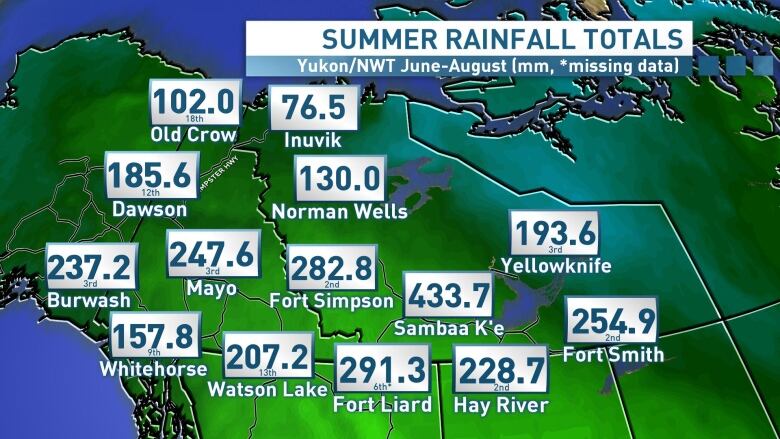The stats are in: It was a rainy summer in the North
Yukoners and those in southern N.W.T. surely noticed the rain and high water levels this summer

If there'sone word that describes summer 2020's weather in Yukon and southern N.W.T., it's rain.
We talked about it a lot and the rain broke countless daily records this year. In the end, we came close to having a record-breaking wet summer across the board.
The rain was a constant in my forecasts this summer, with very few weeks staying clear of that splattering of green and yellow showingrainfall accumulation across my rainfall forecast boards.
And if you didn't notice the rain, you could see it in the high water levels throughout our rivers and lakes.

Rainiest place was the southwest corner ofN.W.T.
So what happened? Well, to start, many low-pressure systems this summer made their way through the Nahanni National Park, Fort Liard and Sambaa K'e, N.W.T.,regions. It's no surprise that those were the rainiest areas in the North.
These systems skirted along the border between the territories and the provinces. This brought rain through the Dehcho and the South Slave regions time after time, meaning that Hay River, Fort Smith and Fort Simpson, N.W.T., all recorded their second-wettest summer in our recorded weather data.
But the one area that got the most rain? Sambaa K'e with a whopping 433.7 millimetres, according to records kept by Environment and Climate Change Canada.It was subject to major bursts of rainfall and also lesser days, consistently being under low-pressure conditions.

Troughs of low-pressure through Yukon
In Yukon, the rainiest city was Mayo, which recorded 247.6 millimetres of rain and the third-rainiest meteorological summer on record. The community was almost always in the path of the rainfall coming from troughs of low pressure reaching from Alaska through to Alberta (which often went over the N.W.T.'s Dehcho region as well).
For weeks on end, you could draw a line and watch rainfall move along it, and this brought those rainy and grey conditions to the entire territory.
Rainy days right across the board, including the capitals
Yellowknife and Whitehorse both had rainy summers.
In Yellowknife, it was the third-rainiest summer in the weather records with 193.6 millimetres,behind 2018 (239.0 mm) and 1988 (194.5 mm).
Meanwhile, Whitehorse had its ninth-rainiest with 157.8 mm.
Most cities in N.W.T. and Yukon had a record-breaking rainfall day this summer. Hay River, Fort Simpson and Sambaa K'e all recorded days with more than 40 millimetres of rain.
Washing away threat of wildfires
Though some would have enjoyed a sunnier season, the rainfall amounts across the territories definitely diminished the wildfire risk, and compared to the average, there were fewer fires in both territories through the summer.
So, there's a plus for a rainy season.












_(720p).jpg)


 OFFICIAL HD MUSIC VIDEO.jpg)
.jpg)



























































































